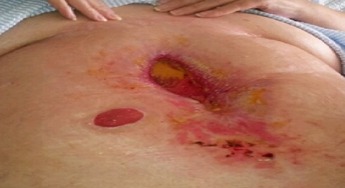Management of a faecal fistula in an abdominal wound
This case study looks at the management of a faecal fistula in an abdominal wound
Submitted by: Kylie Leavy STN, Dandenong Hospital, Victoria, Australia
Patient background
• 44 year old lady who presented to Dandenong Hospital on the 15th of April 2015 with a diagnosis of Pseudomembranous Colitis secondary to Salmonella.
• Proceeded to theatre and she underwent a laparotomy, subtotal colectomy, formation of an end ileostomy and ventral hernia repair.
• Day 9 post op she returned to the operating theatre and had a repeat laparotomy, drainage of intra-abdominal abscess and revision of her ileostomy.
• Day 24 post op she returned to theatre for the third laparotomy with abdominal wash out. Abdomen was left open as a laparostomy wound.
• It was noted at each surgery that the bowel was very friable which resulted in the formation of a faecal fistula in the wound.
This case study outlines the management of the patients wound and fistula during her 426 days in hospital and the strategies used in the attempt to discharge during this time.
Care Management Plan
• eakin fistula appliance (839265) with continuous irrigation (50 ml per hour) and continuous suction (Clements wall suction 100mmhg).
• This system was changed PRN depending on the varying volumes of output from the ileostomy and fistula.
• Wound care training was provided for the nursing staff in the ward to ensure continuity of care.



As the wound healing continued, changes were made to the wound care management plan: the continuous irrigation was reduced to intermittent irrigation to encourage mobility and rehabilitation.
Attempts were made with the use of other appliances and suction omitted, but the very fluid output of about 1500ml per day from the fistula was problematic. The need for intermittent suction connected to the appliance was imperative to maintain a seal.
Preparation for discharge was coordinated with Hospital in the Home. it was necessary to explore avenues of portable suction devices. A Laerdal suction unit was purchased by the hospital.
The Stomal Therapy Team in the hospital created a step by step care plan to ensure continuity of care for an inexperienced community team.
Careplan
1. Use template on wound dressing to size and cut appropriate opening in the bag as shown below.


2. Protect the peri wound skin by picture framing with strips of Eakin cohesive.


3. Position the appliance appropriately.

4. Seal around edges of wound dressing with Opsite Flexigrid (allergy to Tegaderm).
5. Cut rigid connector off the bottom of the appliance.
6. Place suction tubing into the bottom of the fistula bag and secure with an elastic band.

7. Turn on suction for 5 minutes every 2 hours to clear bag of debris and faecal matter. The suction unit has a single on/off switch and the ability to control the level of suction by adjusting the dial on the left of the unit, if needed.
8. When suction not required, remove suction tubing and use the Alligator clip to seal the drainage bag (see below).
Outcome
The team worked together to nurse this lady at home, however due to the complex nature of the high output wound and an under resourced community team, the lady was readmitted to hospital for management. The care plan using the Eakin wound pouch was successfully continued until reoperation and repair.
The management of the fistula and surrounding wound was a challenge to all members of the multi-disciplinary team.
• Capacity to cope with the effluent.
• Skin protection.
• Comfortable in use.
• Flexible on the body which helped to encourage mobility.
• Option to attach to suction.

 US
US 
